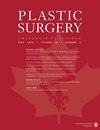乳房缩小术患者使用娱乐性大麻的情况:特征、并发症和术后即刻镇痛需求
IF 0.7
4区 医学
Q4 SURGERY
引用次数: 0
摘要
简介:整形外科尚未明确探讨近期或曾使用过娱乐性大麻的患者的特征、并发症和术后镇痛需求。本研究比较了使用和不使用娱乐性大麻的乳房缩小术患者的特征、并发症和术后镇痛需求。研究方法对 2019 年至 2023 年期间接受乳房缩小术的患者进行了一项回顾性队列研究。研究收集了患者的人口统计学特征、合并症、娱乐性大麻使用情况、术后阿片类药物使用情况以及术后并发症。然后将近期(距上次吸食大麻 1 个月后)或目前吸食大麻的患者与无大麻吸食史的患者进行比较。结果:共纳入 340 名患者,其中 88 人(26%)有吸食大麻史,252 人(74%)无吸食大麻史。吸食大麻组的患者明显比不吸食大麻组的患者年轻(28 岁对 40 岁,P < .01),不吸食大麻组中患有高血压的患者明显多于吸食大麻组(20% 对 6%,P < .01)。吸食大麻组中有更多患者出现血肿(5% 对 1%,P = .041),有更少的患者出现 t 点破裂(4% 对 0%,P = .046),但在控制了包括人口统计学和合并症在内的可能混杂因素后,这些数字在多重逻辑回归分析中失去了统计学意义(P > .05)。使用阿片类药物的比例或阿片类药物的剂量没有明显差异,即使换算成口服吗啡当量也是如此(P > .05)。结论使用大麻和不使用大麻的人群的镇痛需求、术后疼痛程度和并发症相似。仍应鼓励术前进行药物使用咨询,尤其是对寻求乳房缩小术的年轻患者。本文章由计算机程序翻译,如有差异,请以英文原文为准。
The Use of Recreational Cannabis Among Breast Reduction Patients: Characteristics, Complications, and Immediate Postoperative Analgesic Needs
Introduction: The characteristics, complications, and postoperative analgesic needs of patients with a recent or active history of recreational cannabis use have not been explored explicitly in plastic surgery. In this study, the characteristics, complications, and postoperative analgesic needs within a population of breast reduction patients who use and do not use recreational cannabis were compared. Methods: A retrospective cohort study was carried out on patients who underwent breast reduction between 2019 and 2023. Demographics, comorbidities, recreational cannabis use, postoperative opioid use, and postoperative complications were collected. Patients with a recent history (<1 month since last cannabis use) or current cannabis use were then compared to patients with no history of cannabis use. Results: In total, 340 patients were included, 88 (26%) patients had a history of cannabis use and 252 (74%) did not. Patients in the cannabis-using group were significantly younger than in the non-cannabis-using group (28 years vs 40 years, P < .01), and significantly more patients in the non-cannabis group had hypertension (20% vs 6% P < .01). More patients in the cannabis-using group had hematomas (5% vs 1%, P = .041) and fewer had t-point breakdown (4% vs 0%, P = .046), but these figures lost statistical significance on multiple logistic regression analysis after controlling for possible confounding factors including demographics and comorbidities ( P > .05). There were no significant differences in proportions of opioid use or by doses of opioids, even when converted to oral morphine equivalents ( P > .05). Conclusion: The analgesic needs, postoperative pain levels, and complications between cannabis-using and non-cannabis-using cohorts were similar. Counseling on substance use preoperatively should still be encouraged, especially in younger patients seeking reduction mammaplasty.
求助全文
通过发布文献求助,成功后即可免费获取论文全文。
去求助
来源期刊

Plastic surgery
Medicine-Surgery
CiteScore
1.70
自引率
0.00%
发文量
73
期刊介绍:
Plastic Surgery (Chirurgie Plastique) is the official journal of the Canadian Society of Plastic Surgeons, the Canadian Society for Aesthetic Plastic Surgery, Group for the Advancement of Microsurgery, and the Canadian Society for Surgery of the Hand. It serves as a major venue for Canadian research, society guidelines, and continuing medical education.
 求助内容:
求助内容: 应助结果提醒方式:
应助结果提醒方式:


